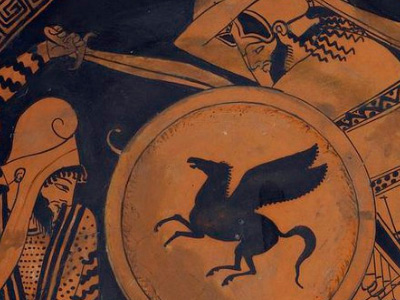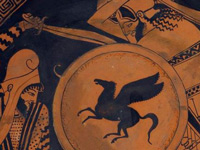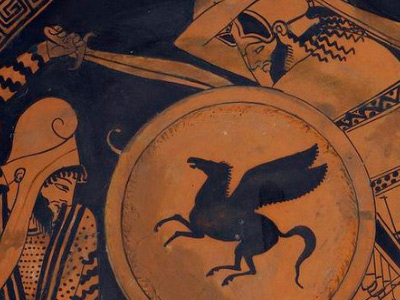Battle of Plataea (479 BC)

Battle
Once the Persians discovered that the Greeks had abandoned their positions and appeared to be in retreat, Mardonius decided to set off in immediate pursuit with the elite Persian infantry. As he did so, the rest of the Persian army, unbidden, began to move forward. The Spartans and Tegeans had by now reached the Temple of Demeter. The rearguard under Amompharetus began to withdraw from the ridge, under pressure from Persian cavalry, to join them. Pausanias sent a messenger to the Athenians, asking them to join up with the Spartans. However, the Athenians had been engaged by the Theban phalanx and were unable to assist Pausanias. The Spartans and Tegeans were first assaulted by the Persian cavalry, while the Persian infantry made their way forward. They then planted their shields and began shooting arrows at the Greeks, while the cavalry withdrew.
According to Herodotus, Pausanias refused to advance because good omens were not divined in the goat sacrifices that were performed. At this point, as Greek soldiers began to fall under the barrage of arrows, the Tegeans started to run at the Persian lines. Offering one last sacrifice and a prayer to the heavens in front of the Temple of Hera, Pausanias finally received favourable omens and gave the command for the Spartans to advance, whereupon they also charged the Persian lines.
The numerically superior Persian infantry were of the heavy (by Persian standards) sparabara formation, but this was still much lighter than the Greek phalanx. The Persian defensive weapon was a large wicker shield and they used short spears; by contrast, the hoplites were armored in bronze, with a bronze shield and a long spear. As at Marathon, it was a severe mismatch. The fight was fierce and long, but the Greeks (Spartans and Tegeans) continued to push into the Persian lines. The Persians tried to break the Greeks' spears by grabbing hold of them, but the Greeks responded by switching to swords. Mardonius was present at the scene, riding a white horse, and surrounded by a bodyguard of 1,000 men; while he remained, the Persians stood their ground. However, the Spartans closed in on Mardonius and a Spartan soldier named Arimnestus killed him. According to Plutarch, Arimnestus killed him by a blow to the head with a stone, a form of death which had been foretold to Mardonius by an oracle; some modern historians have called it unlikely that a Spartan would use such a weapon. With Mardonius dead, the Persians began to flee; although his bodyguard remained, they were annihilated. Herodotus claims that the reason for their discomfort was a lack of armour. Quickly the rout became general, with many Persians fleeing in disorder to their camp. However, Artabazus (who had earlier commanded the Sieges of Olynthus and Potidea), had disagreed with Mardonius about attacking the Greeks, and he had not fully engaged the forces under his command. As the rout commenced, he led these men (40,000, according to Herodotus) away from the battlefield, on the road to Thessaly, hoping to escape eventually to the Hellespont.
On the opposite side of the battlefield the Athenians had triumphed in a tough battle against the Thebans. The other Greeks fighting for the Persians had deliberately fought badly, according to Herodotus. The Thebans retreated from the battle, but in a different direction from the Persians, allowing them to escape without further losses. The Greeks, reinforced by the contingents who had not taken part in the main battle, then stormed the Persian camp. Although the Persians initially defended the wall vigorously, it was eventually breached; the Persians, packed tightly together in the camp, were slaughtered by the Greeks. Of the Persians who had retreated to the camp, scarcely 3,000 were left alive.
According to Herodotus, only 43,000 Persians survived the battle. The number who died, of course, depends on how many there were in the first place; there would be 257,000 dead by Herodotus' reckoning. Herodotus claims that the Greeks as a whole lost only 159 men. Furthermore, he claims that only Spartans, Tegeans and Athenians died, since they were the only ones who fought. Plutarch, who had access to other sources, gives 1,360 Greek casualties, while both Ephorus and Diodorus Siculus tally the Greek casualties to over 10,000.
HISTORY

RESOURCES
This article uses material from the Wikipedia article "Battle of Plataea (479 BC)", which is released under the Creative Commons Attribution-Share-Alike License 3.0.
© Stories Preschool. All Rights Reserved.









